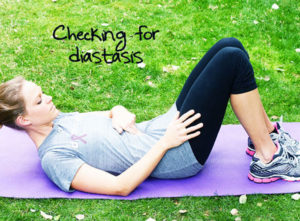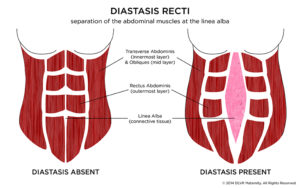Diagnosing a diastasis and what you can do about it
In my last post we spoke about a commonly overlooked reason for a post pregnancy pooch that you cannot seem to lose no matter how much you exercise or diet. This separation of abdominal muscles causing the bulging appearance of the stomach is called diastasis recti. This post will cover how to check for a diastasis and some of the things you need to consider if you have this condition.
A test to determine a diastasis can be done by yourself at home or you can speak to your physiotherapist or gynecologist who will check for it.
Diastasis gaps are typically measured in finger width. So you could be diagnosed as having a diastasis which is 2 fingers wide or 4.5 fingers wide. I will not go into how to self-diagnose as there are many videos and tutorials available online. Here is one that explains it quite clearly: diagnosing a diastasis.
If you have a diastasis there are a few things that you need to know:
- This does not mean you will never have a taut tummy ever again; you will probably just have to exercise with some modifications and avoid certain exercises altogether.
- If people around you- your doctor or family and friends try to tell you that this is normal and just the way all women’s tummies look after a baby it is NOT true. A tummy with a wide gap (diastasis) looks distinctly different from just regular flab that accumulates around the tummy.
- A tummy with a diastasis tends to dome or look like a bump when you either get up from a lying down position or any movement which cause you to jack knife or bend from the hip thigh joint.
- The traditional Indian post-partum ritual of tying a saree around the tummy may have been dismissed by many as outdated and pointless (I am guilty of saying this as well) however there seems to be some merit in the practice. Providing support to the sagging tummy by splinting helps to provide some support to the weakened stomach muscles and restricts you from bearing down or creating intra-abdominal pressure. However it is important to note that along with splinting it is essential to start strengthening abdominal muscles, otherwise it is of no use and your tummy will continue to pooch out as soon as the splint is removed.
- All women who have been pregnant have had some degree of muscle separation, for some the gaps reduces naturally, typically for first time mothers, women who have already been exercising prior to getting pregnant while for older moms, second pregnancies, multiples the diastasis may be wider and not heal naturally.
- If your gap is less than 2 fingers wide this is considered normal after pregnancy and should heal by itself by doing diastasis safe exercises before moving on to regular exercise. If the gap is more than 2 fingers or more following “Tupler technique” will certainly be of help. This is a non-surgical technique developed by Julie Tupler (a registered nurse) which is considered to be the gold standard of diastasis healing throughout the world.
- Doing exercises that involve jack knifing or rolling up (like when you get out of bed) or any exercises that cause your abdominals to stretch out like back extensions will worsen the conditions.
- Pilates exercises can be modified to suit conditions like diastasis. More importantly the emphasis on using the pelvic floor muscles in Pilates exercises makes it very suitable for post-partum fitness. However it has to be said that not all Pilates exercises are suitable for people with a diastasis. It therefore becomes very important to find an instructor who understands post-partum anatomy and can guide you through exercises that are safe and suitable.
Whether you are a new mom or someone with an older child it is not too late to try and heal your diastasis. Finding the right instructor who can work with you and who understands the condition is important. Enjoy your baby and work your way back to a fit body slowly and safely!


MOST COMMENTED